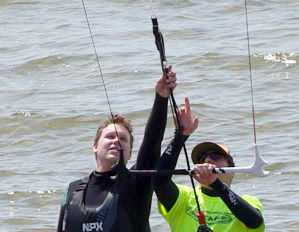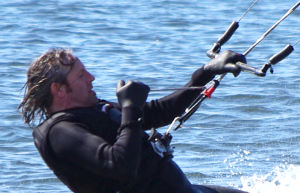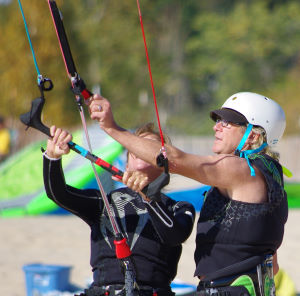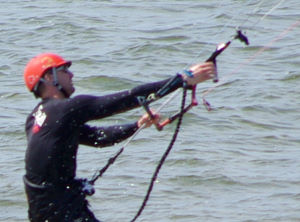What Does a Trim Strap Do?
What Does a Trim Strap Do?
 by Jake Mitchell
by Jake Mitchell
When kitesurfing, a trim strap allows the rider to make further adjustments to the line lengths (generally the front) to alter the power of the kite. The trim strap is always accessible from the bar, more popular configurations delivered in the form of fabric straps, stopper balls, or strap/cleat systems. Identifying the trim strap is something that should be done during your pre-flight check when on a new kite. The major difference between sheeting and trimming is that sheeting adjusts the kite's power relative to bar position, whereas trimming adjusts the kite's base power output. Also, unlike sheeting, which changes a kite's back line lengths, sheeting affects the front lines, adjusting the angle of the kite into the wind, or angle of attack.
 To decrease a kite's power, the trim strap is pulled in, or towards the rider. This shortens the length of the front lines, lowering the leading edge and making the kite less efficient. Conversely, pulling on the re-power line or strap increases the length of the front lines, allowing for an angle that generates more lift and deflection. Especially in lighter winds, trimming a kite can result in more frequent oversheeting and backstalling, making it important that the trim level appropriately reflects the wind speed and subsequently power in the kite. Foil kites are particularly susceptible to this. Trimming is particularly important when unhooking or riding in surf to make the power in the kite more situationally manageable. While trimming extends the wind range of a kite, it definitely is no replacement for sizing the appropriate kitesurfing kite for the conditions. Essentially, the ability to trim adds another way to depower your kite, adding to its safety and versatility.
To decrease a kite's power, the trim strap is pulled in, or towards the rider. This shortens the length of the front lines, lowering the leading edge and making the kite less efficient. Conversely, pulling on the re-power line or strap increases the length of the front lines, allowing for an angle that generates more lift and deflection. Especially in lighter winds, trimming a kite can result in more frequent oversheeting and backstalling, making it important that the trim level appropriately reflects the wind speed and subsequently power in the kite. Foil kites are particularly susceptible to this. Trimming is particularly important when unhooking or riding in surf to make the power in the kite more situationally manageable. While trimming extends the wind range of a kite, it definitely is no replacement for sizing the appropriate kitesurfing kite for the conditions. Essentially, the ability to trim adds another way to depower your kite, adding to its safety and versatility.


